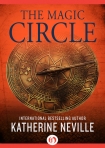The Magic Circle, Katherine Neville [parable of the sower read online .TXT] 📗

- Author: Katherine Neville
Book online «The Magic Circle, Katherine Neville [parable of the sower read online .TXT] 📗». Author Katherine Neville
“As for the Templars’ vast hoards of treasure,” he added, “these reputedly included holy relics possessing enormous powers, like the sword of Saint Peter and the spear of Longinus, not to mention the Holy Grail itself—relics that were sought by courtly knights throughout the Middle Ages, from Galahad to Parsifal. The whereabouts of this treasure, however, is a mystery that remains, down to the present, unresolved.”
Of course, I hadn’t overlooked the parallels between Father Virgilio’s medieval whodunit and all the previous details dropped by everyone else. There were the references to Solomon and his temple, tying them to everyone from the Queen of Sheba to the Crusaders. But Virgilio’s tale seemed also to point elsewhere: once again, to a map. Though I couldn’t see the whole pattern, I was hoping at least to tie up a few loose threads. Then Wolfgang did it for me as we looked at Virgilio’s map before us on the trestle table.
“It’s incredible the way things leap out, when you look at a map,” Wolfgang said. “I now see how many of the old epics—the Icelandic Eddas, even the earliest Grail legends of Chrétien de Troyes—describe battles and adventures that are centered on this one region. When Richard Wagner wrote the Ring cycle that Hitler admired so much, he based it on the Germanic epic the Nibelungenlied, which tells how the Storm from the East, Attila the Hun, was fought by the Nibelungs—who were none other than the Merovingians.”
“But all that happened long before the Crusades,” I pointed out. “Even if we’re talking about the same piece of turf, how does it relate to Bernard or the Templars, hundreds of years later?”
“Everything,” said Virgilio, “is shaped by what went before. In this case, it relates to three kingdoms: the one established by Solomon’s father, based in Jerusalem; the kingdom set up by the Merovingians in fifth-century Europe; and the Christian kingdom of Jerusalem, founded five centuries later in the Crusades, by men who came from the same region of France. There are many theories, but they all pertain to one thing: the blood.”
“The blood?” I said.
“Some claim the Merovingians carried sacred blood,” Virgilio explained. “A bloodline descended perhaps from Christ’s brother James, or even from a secret marriage between the Magdalene and Jesus himself. Others say the blood of the Saviour was collected by Joseph of Arimathea in the Holy Grail, a vessel later taken by the Magdalene to France and preserved against a day when science could restore a human being to flesh.”
“You mean, like DNA re-creation, or cloning?” I said with a grimace.
“Such views, of course, are not only heretical but, if I may say so, rather foolish,” said Virgilio with a wry smile. “There is one curious fact we do know about bloodlines: that all the kings of Jerusalem over the years of Christian rule were descended from one woman, Ida of Lorraine.”
It hadn’t escaped my attention that there were two Mount Idas of importance. The first, on Crete, was the birthplace of Zeus, a major site of Dionysian worship, and also connected to Hermione on the map. The second, on the coast of modern-day Turkey, was the site of the Judgment of Paris; from it the gods had watched the progress of the Trojan War. And now a third Ida, according to Virgilio, was the ancestress of every king who’d ruled Jerusalem for two hundred years. A woman from the very region we’d spoken of. And apparently that wasn’t all.
“The big story of the high Middle Ages in Europe,” said Virgilio, “was not the Crusades, but rather the blood feud between two families known in history books by the Italian names Guelphs and Ghibellines. They were actually German: Bavarian dukes called Welf, meaning whelp or bear cub, and Swabian Hohenstaufens called Waiblingen, or honeycomb. One man alone, coincidentally also a protégé of Bernard de Clairvaux, combined the blood of these adversaries. This was Frederick Barbarossa, who survived Bernard’s disastrous Second Crusade to become Holy Roman Emperor.
“As the first ruler to unite in his veins the powerful bloodlines of those two Germanic tribes, whose private battles had defined the history of the Middle Ages, Barbarossa was regarded as the saviour of the German people, someone who would one day unite them to lead the world.
“He went on to forge Germany into a major power, and to launch the Third Crusade at age sixty-six. But en route to the Holy Land, he mysteriously drowned while bathing in a river in southern Turkey. His famous legend maintains that Barbarossa sleeps today within the mountain of Kyffhäuser in the center of Germany, and that he’ll rise to come to the aid of the German peoples in their hour of need.” Virgilio folded his hands on the map and asked me, “Does it remind you of another story?”
I shook my head as Wolfgang placed his finger on the map and slowly traced a circle around the region Virgilio had spoken of. I froze at his next words.
“According to Hitler’s architect, Albert Speer,” Wolfgang told me, “it’s precisely this area where Heinrich Himmler wished to create, after Germany’s victory in the war, an ‘SS parallel state.’ Himmler planned to put high-ranking storm troopers there with racially pure wives selected by the genealogy research branch of the SS, and to





Comments (0)